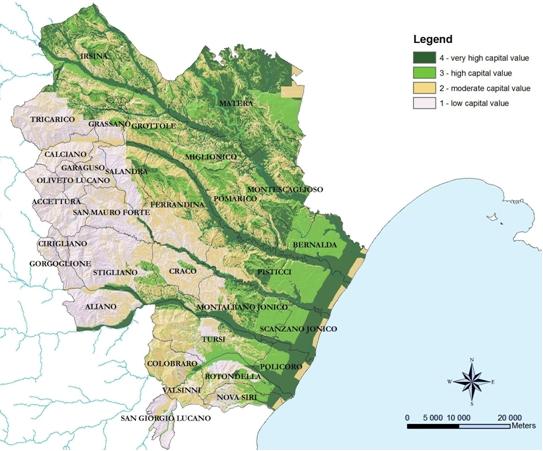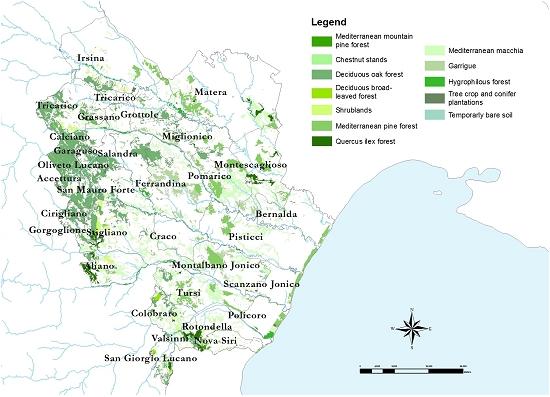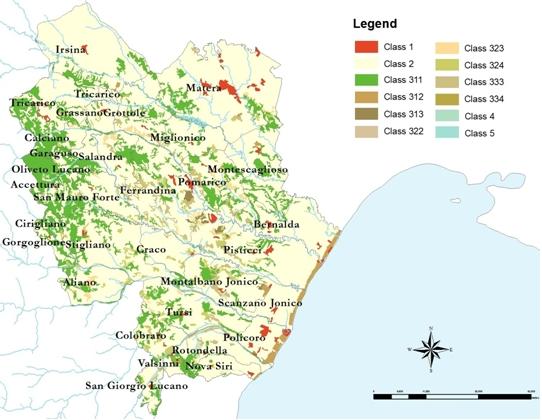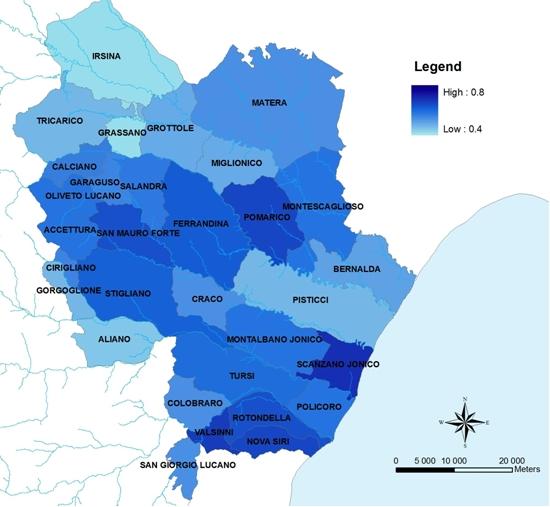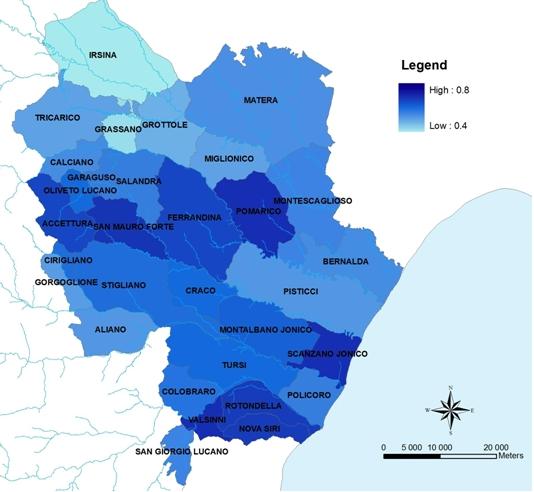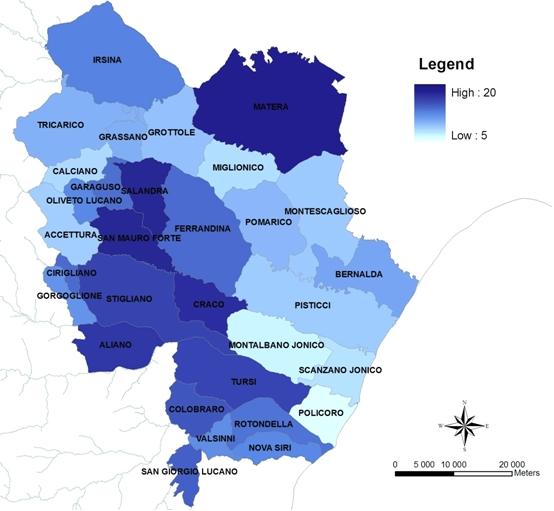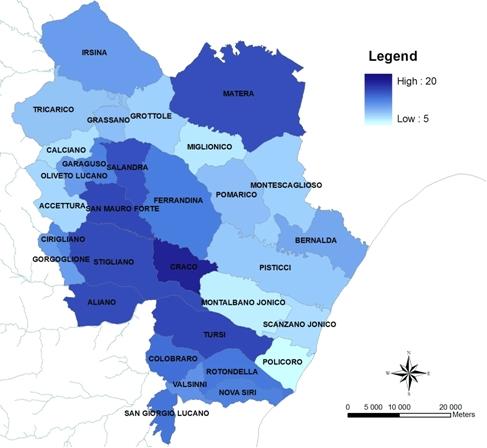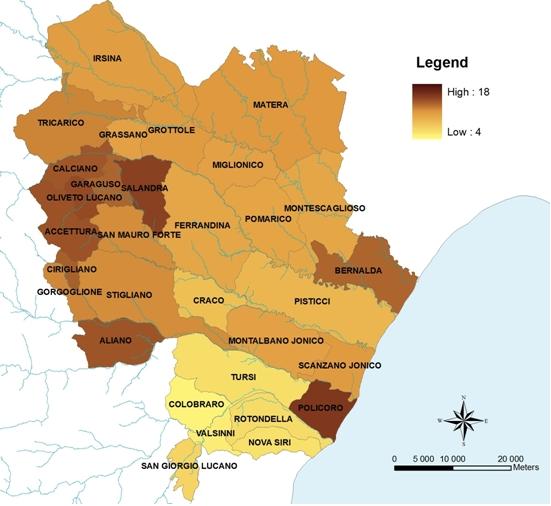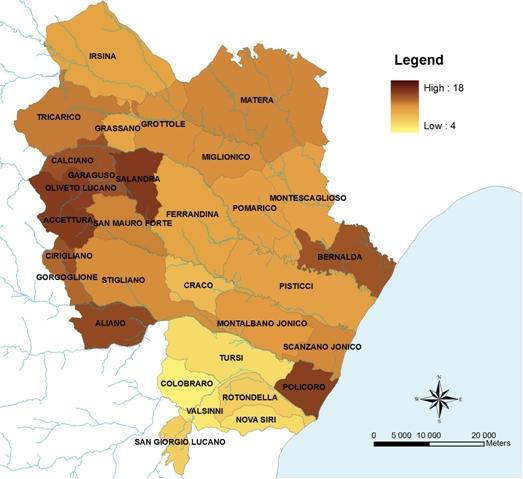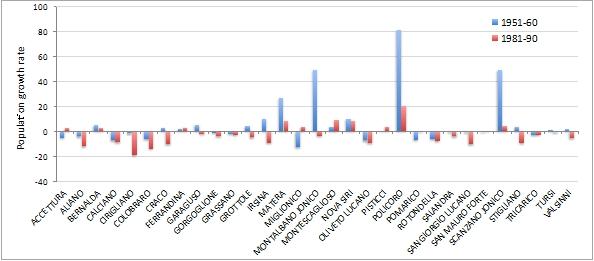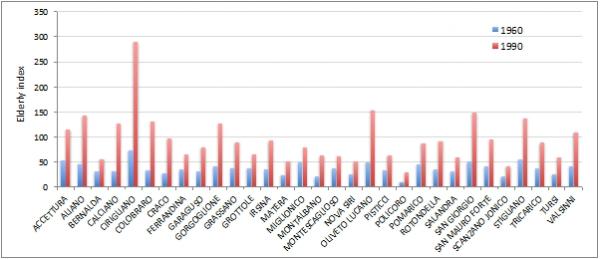Study sites in cropland
Study sites in grazing land
Study sites in forests
Traditional forest management period: 1960 to 1990
| Lead authors: | Agostino Ferrara, Giovanni Quaranta |
| Contributing author: | Angelo Nolè, Guiseppe Mancino, Luca Salvati, Francesco Ripullone |
| Editor: | Alexandros Kandelapas |
Editor's note 5Aug13: Source D332-2.2.
Assessment of natural, economic and social capitals
| Natural capital | |
| Assessment | In this period, the climate component of natural capital can be defined as moderate-low, because of the level of aridity and the long and dry summers that characterize the climate of the area. Data confirms the (increasing) severity of arid conditions, with a gradient towards the south east, where the marked characteristics of Mediterranean climate with long, dry periods and high temperatures during summer, associated with a decrease in average annual rainfall negatively reflect on the ecophysiological efficiency of forests and their phytosanitary status. This variability also plays a key role in the mutual relationships of the SES components over time and space.
Soil capital varies greatly and by a gradient that shows increasing value in the northwest- southeast direction (the opposite direction to the climate capital). Lowest values are seen in the badlands (Calanchi) area, in the west part of the area which is characterized by steep slopes and very high levels of soil erosion. Soil capital has high spatial and low temporal variability and, as expected, forest soils are worse than others. The recolonization processes of forests (secondary succession) on abandoned/uncultivated areas leads to a slight decrease of overall quality of forest soil capital.
Vegetation capital also has a northwest-southeast gradient which corresponds with the coastal-inland gradient. There are different trends between the municipalities that are related to the changes in the forest composition due to recolonization processes occurring in the area and to the many reafforestation projects (mainly along the coastal rim).
Water capital (defined by using the soil moisture ratio) is slightly higher in forest shrubland areas than in other land cover types. In general this slight increase can be related to the general increase in forest cover. During the period water capital shows a higher spatial than temporal variability with no significant territorial trend. |
| Critical functions | If it is considered that areas with low surface water runoff have a higher capacity to regulate hydrological processes, most of the area is in quite good environmental condition. However, higher levels of runoff are noted in Aliano, Craco, Matera, Salandra, San Mauro Forte, Stigliano e Tursi. Indeed, the village of Craco is completely abandoned when it is destroyed by a landslide.
Primary production. The mean value of the mean annual forest biomass increment ranges from 5 to 15 t ha-¹ year-¹ of dry matter with the average being nearly 11 t ha-¹ year-¹. During the period the trend is for an increase of biomass production, due to an increase in forest cover.
Biodiversity support and conservation. The total area under land protection regimes slightly increased. Naturality index (richness of wood species at map scale) also showed a moderate increase, apart from in the areas of deforestation driven by urbanization, urban sprawl, second home speculation and seasonal tourism concentration (e.g. the coastal forest of Policoro). While relatively stable at the regional level, Pielou's index (a high index value indicates high landscape biodiversity) shows a diverging trend in coastal and inland municipalities, which decrease and increase respectively over the period. This was generally observed in hilly, inland municipalities more than the coast where biodiversity is generally limited and relatively stable (or slightly decreasing) over time. |
| Critical variables | A general increase in soil water availability is observed. The climate component worsens slightly but affects only moderately the critical functions of forest ecosystems. Trends in critical functions seem more connected to changes in vegetation capital component (e.g. recolonization processes). As expected, the slowest capital component in the system is soil. |
| Economic capital | |
| Assessment | Between 1960 and 1990, employment generally shifts from agriculture to services and tourism, with dramatic changes in the towns of Matera, Policoro, Grassano, Nova Siri, Pisticci and Bernalda. Employment in silviculture (a key variable in marginal land in remote areas) is relatively stable and in some communities increases. Between 1970 and 1990, the total number of farms undergoes significant reduction, while average farm size slightly increases. The temporal dynamic of forested areas is noteworthy if linked to the enterprise property; the main variations observed are localized in few municipalities: Accettura, Calciano, Oliveto Lucano and Policoro (all of which decrease) and Matera, Pomarico and Aliano (all of which increase) based on different territorial accessibility and land tenure shaping the form and function of landscapes. There is a significant improvement in road connections and removal of isolation. Availability of agricultural machinery also improves. As pasture in forested areas is widespread here, the impacts on the vegetation capital caused by presence of livestock serves as an indicator of human presence and land use. Livestock pressure is relatively stable except in mountain and upland municipalities. Forest surface increases slightly due to land abandonment. |
| Critical functions | - |
| Critical variables | Economic capital components show marked changes, particularly with regard to the growth of the tourism sector, decreases in the agricultural sector and growth of services. Changes in the activity rate and workers in the silviculture sector are also valuable in some municipalities. Variables that remain relatively stable are agricultural machinery, density of animals and industrial employment. A marked decrease is observed in the number of medium sized farms and a generalized increase in the number of small and large farms. |
| Social capital | |
| Assessment | Although average indicators of demographic capital remain quite stable, a marked population change is observed along the coastal-inland gradient. Municipalities that gain population are the principal city of the prefecture (Matera) and towns along the coastal rim (Policoro, Nova Siri, Scanzano Jonico and Bernalda) caused by the concentration of immigrant workers attracted by tourism and agriculture jobs. Population changes due to ageing are observed in inland municipalities and are accompanied by a progressive trend of depopulation and land abandonment.
Human capital follows wider national and regional trends. There is a rapid increase in average educational level. The increase in secondary school and university graduates is spatially homogeneous and high. |
| Critical functions | - |
| Critical variables | Social capital components show a great degree of change. Of particular note is the improvement in human capital related to education and skill availability. Changes in the demography are possibly related to other social and economic changes, such as movement to the coast and larger towns and the general increase in development – particularly of second homes along the coast. The institutional and cultural components change at a slower pace than others. In particular, impacts of political and administrative changes (devolution) take several years to appear. Changes in culture are also slow and difficult to observe, as rural communities tend to hold closely to their heritage. The existence of generally aged remote rural populations, more reluctant to embrace cultural changes, consolidate the trend. Other dynamic processes are those related to early tourism pressure in coastal areas and environmental pressures such as forest fires. In particular forest fires increase in time and space and result in a spatial differentiation of fire risk. Fire risk (MEDALUS methodology, Kosmas et al. 1999) also increases over time due to the increase of shrublands (recolonization processes) and conifer (afforestation) in forest composition. Fire risk increase is connected with both horizontal continuity of fuels, found in shrubland and Mediterranean maquis, and vertical continuity found in reforestations on badlands or along the coast. |
The main LEDD problems and responses
Forest productivity decline is a key LEDD problem in Mediterranean forests/shrubland firstly because it affects the capacity to produce goods and services and secondly because of its relationship to other critical functions such as regulation of hydrological processes and biodiversity support and conservation. In this area, forest productivity decline shows a typical northwest southeast gradient with worsening environmental quality, function, and structure in the southwest areas. This is due to several interconnected issues including spatial variability of the meso-climate, poor land management, aridity, over-grazing, forest fires and (at least in some areas) tourism pressure.
Loss in biodiversity and forest fragmentation are interrelated problems that originated in human interventions in the past century (land for agriculture) combiled with pressure caused by intense grazing, forest fires and, in recent years, tourism. During this period, fragmentation indices show a positive trend mainly due to natural reforestation caused by rural land abandonment in inland areas
Soil erosion and deterioration. In this period the area shows medium-high rates of soil erosion depending on site-specific characteristics and vegetation cover. As expected, forest areas show lower and decreasing levels of erosion than agricultural land.
Water stress and phytosanitary deterioration of forest cover and land desertification. Using NDVI measured at the end of the dry season (i.e. during conditions of maximum water stress) and Drought Resistance, the level of resistance to water stress worsens both in forest land and at large. The ESA and Aridity (UNEP) indices show a slight worsening due to the environmental conditions linked to climate, soil and vegetation. The increase in land vulnerability to desertification, however, is not homogeneous at the spatial level but follows a coastal-inland gradient, typical of Mediterranean semi-arid land.
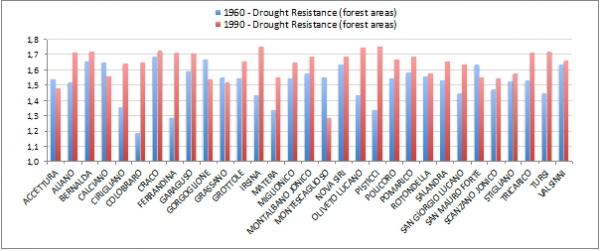
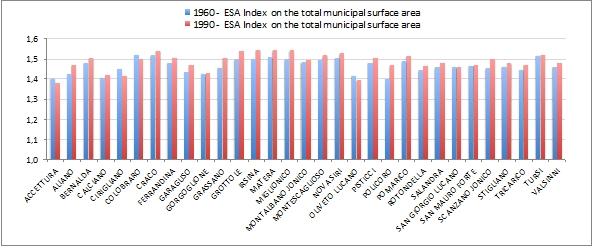
All forest/shrubland problems in the Matera study site are met with a common set of possible responses including:
- forest fires (negative, unplanned)
- overgrazing (negative, unplanned)
- population dynamics coupled with land abandonment (negative in the short term/positive in the long term, unplanned)
- forest and environmental policies (no major effects in the period, planned)
- forest management as usual (no effect/negative, unplanned).
Forest fires are an effective driver in worsening of LEDD problems, affecting land cover and forest populations dynamics, often to the point of irreversibility (e.g. repeated fires in conifers in the coastal area). Although, agricultural activities such as burning shrubland for regeneration or grazing is the main source of fire, fire prevention and fighting capability is limited. Forest fires impact on SES critical functions.
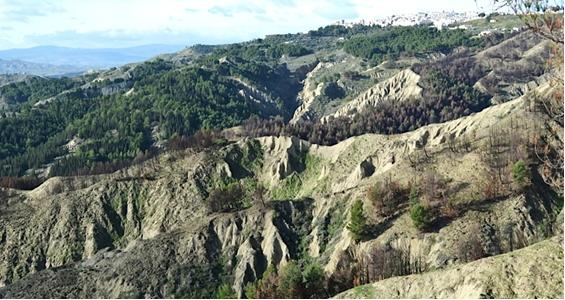
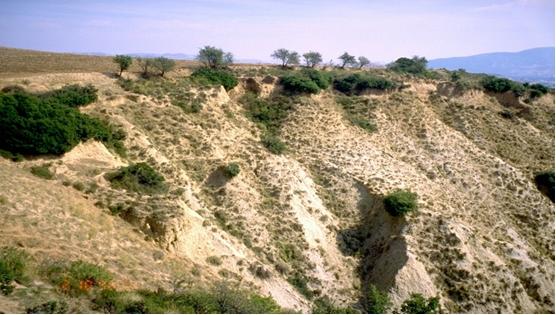
Overgrazing represents another effective LEDD driver, despite the generally positive aspects of husbandry in rural areas, including prescribed grazing. Overgrazing may also linked to traditional land tenure rights where there is poor compliance. Cattle are the main forest grazers, with sheep (and sometimes goats) usually concentrated in shrublands and neighbouring forest areas. Overgrazing negatively impacts on all critical functions of the SES leading to soil erosion and land degradation.
Land abandonment is one of the responses to the economic crisis of the 1970s forcing farmers to abandon activities in marginal and drought prone areas. This is a negative response in terms of land degradation and desertification due to the absence of adequate land management levels and maintenance. Land abandonment also causes changes in farm structure (on one hand farm fragmentation vs larger farms on the other). These phenomena have negative impacts on social and economic capital (loss in land productivity, loss in capital for restoration, social cost of abandonment, loss of participation and cultural heritage). Land abandonment also negatively impacts on forest productivity and regulation of hydrological processes, mainly due to the ageing of forests.
Long term land abandonment does have positive impacts on forest ecosystems in terms of forest expansion due to natural dispersal, increase of forest understory biomass, increase in biodiversity and ecosystem stability.
Policy context
AK: to check that implementation, impacts and effectiveness of selected policies are discussed in this text. Look at D342 to see if there is any additional information.
In the policy field, the period is dominated by institutional and administrative reforms started at the beginning of the 1970s. Forest policy has been slow to change, governed by:
- Royal Decree 3267/1923 on "Legislative reorganization and reform in matters of mountain forest and lands" and the relative implementing Regulations. This legislative instrument has been not implemented in Matera for more than 70 years. While FMPs are not prepared, regional regulations for forestry are to some extent applied.
- Mountain Law 991/1952 and New Mountain Law 97/1994 defining policies for mountain areas through sustainable development of the mountain environment.
Forest policy during this period can be considered as minimally effective with minimal or even negative impacts, depending on local conditions.
Nevertheless the period sees an increase in forest cover due to both natural expansion and afforestation programs as part of soil protection policy funded by the Cassa per il Mezzogiorno. The Agency also provides finance for hydrogeological soil protection interventions (landslide protection, soil stability hydraulic regulation infrastructures) and reforestation aimed at soil erosion protection and hydraulic regulation.
Nature protection (biodiversity) policies and instruments are also partially applied. The lack and/or poor implementation of environmental policies may act as a driver for social and economic decline resulting in land abandonment.
Properties of the system
AK: to check if there is any further relevant information in D333
Natural capital: Potential available for change can be estimated as a function of the 'amount' of available capitals (see above).
Robustness of natural capital is the capacity of a natural or semi-natural ecosystem to maintain its functioning properties in periods of severe drought. The robustness index shows different values throughout the site during this period.
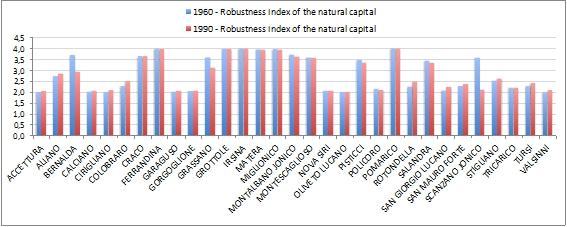
The robustness of the economic capital is evaluated in terms of the quality of management in the form of adoption of a Forest Management Plans. Data indicates a critical condition, with no Forest Management Plans active in the area and very few areas under protection.
Diversity of the natural capital, is assessed through the Naturality index (species composition at forest level). With regard to the diversity of economic capital, analyses confirms the marked urban-rural gradient, active in determining strong differences in unemployment rate between coastal and inland areas as well as a significant concentration of workers in the forestry sector. The importance of the agricultural sector is also evident.
Redundancy of the natural capital component (as measured by the Pielou index) is generally higher in upland municipalities and decreases more or less rapidly in lowlands and coastal municipalities.
Connectedness of the natural capital as evaluated through the use of a Proximity Index is relatively high in the inland zone (indicating the good environmental quality of the mountain landscape) and partly good in the site as whole, despite the strong gradient from coastal to inland areas. The level of connectedness of economic capital seems to have risen throughout the study site.
Rapidity of the natural capital component measured as recovery from disturbance varies from very low to high with an overall moderate mean. The highest values are found in areas where the prevailing forest type is Mediterranean maquis, which has a quick resprouting capacity after disturbance, whereas lower values are found in high forests or coppices.
Economic captial: --
Social capital: --
Socio-ecological resilience
AK: to be added, source: D333
Socio-ecological fit of the dominant response to LEDD
AK: to be added, source: D333

